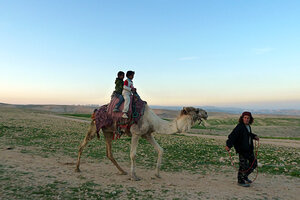Middle East nomads, lost in translation
The language barrier makes it hard for non-Arab tourists to understand the Bedouin lifestyle, but Abdullah Zhaeka's English and Hebrew skills are bridging the gap.

Abdullah Zhaeka leads Bedouin children on a sunset camel ride after bringing a group of tourists to his family's camp on the outskirts of Ubeidiya, West Bank.
Chelsea B. Sheasley
Ubeidiya, West Bank
Abudllah Zhaeka is rarely far from his camel. It’s his economic lifeblood and his companion around the Bedouin camp he lives in, where kids often beg him for rides. The two are together so often that he thought some of the first tourists he gave rides to were calling him a camel when they tried to compliment the animal.
“I said what, have I not washed my hair enough? Why are they calling me a camel?” he recalls with a grin as he holds out a section of his tangled curly hair for evaluation.
That incident sparked Zhaeka’s ambition to learn English, which he did while working with an American tour guide. Now he boasts that he can speak English, Hebrew, and Arabic. His language skills have attracted a growing number of tourists to his village, many of whom are surprised that he dropped out of high school and worked as a shepherd before getting into tourism, instead of going to university.
“They don’t understand it’s very different for the [Bedouin] kids to go to school. It’s 1.5 hours away walking. They don’t want to finish [school]. They want to be outside,” he says as he squats in front of a tent he put up hours earlier for a tour group to sit in as they eat maklouba, a traditional Arab dish of rice, potatoes, and chicken.
The Bedouin camp where Zhaeka grew up and lives in today lies between the Israeli settlement of Kedar and the Arab town of Ubeidiya, a few miles outside Jerusalem in the West Bank.
Zhaeka and others in his camp, where roughly 200 people live in barebone tin and wood shacks, say they’d like to get electricity and maybe even build a school nearby. While the Bedouin are known for their nomadic ways, some in this camp have been there since the 1950s and the consensus is for staying put.
The Israeli government estimates that at least 70,000 Bedouin, more than one-third of the total Bedouin population, live in unrecognized encampments like Zhaeka’s – most in the Negev desert, disconnected from water and electricity grids.
Prime Minister Benjamin Netanyahu's cabinet has passed two plans in the past two years to relocate 20,000 to 30,000 Bedouin into government-approved villages. But those plans have been controversial because of claims that Bedouin input wasn't solicited and that thousands of people will be uprooted unwillingly.
As for Zhaeka, he hopes the 100 to 200 tourists he brings to the camp a month for camel rides and traditional meals will start to bring a greater flow of capital into the area and translate into political support for the Bedouin.
An optimist at heart, Zhaeka speaks boldly of peace but insists that Bedouin land claims are just as important as Israeli and Palestinian ones.
“In 10 years I want every people to live on this land as brother and sister,” he says.

